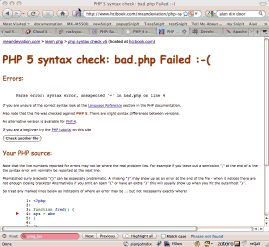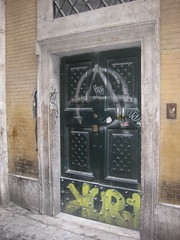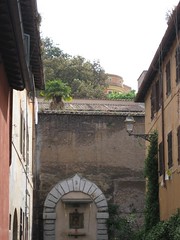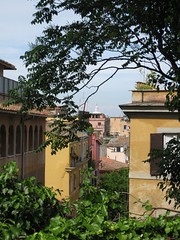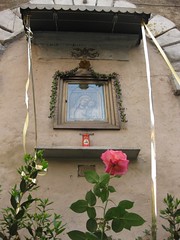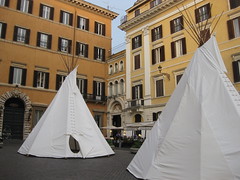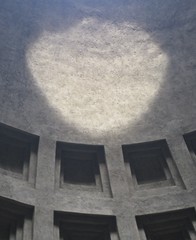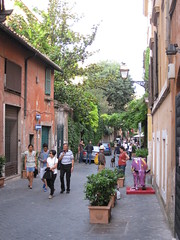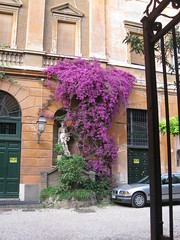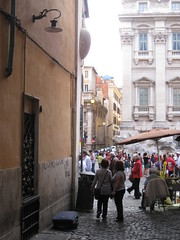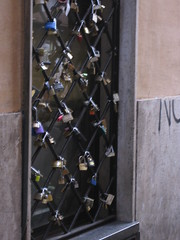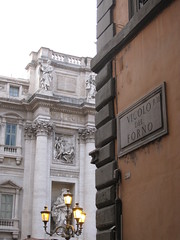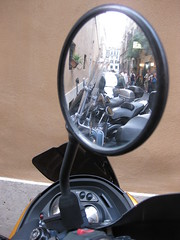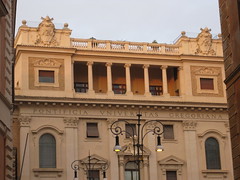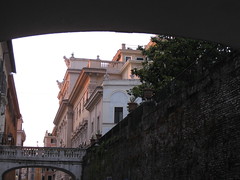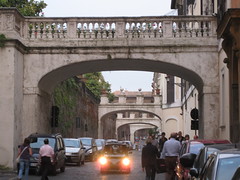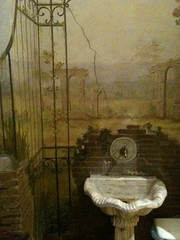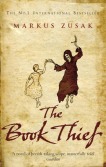 I have just finished reading Markus Zusak’s “The Book Thief“, about a small girl in wartime Germany and narrated by Death, as in the one who comes to take souls. Amongst the hatred of Nazism and falling bombs, the story is of despair and love, cruelty and courage, hard words and big hearts, but told with wry humour and in a dry matter-of-fact prose so that it was only on the last few pages I wept.
I have just finished reading Markus Zusak’s “The Book Thief“, about a small girl in wartime Germany and narrated by Death, as in the one who comes to take souls. Amongst the hatred of Nazism and falling bombs, the story is of despair and love, cruelty and courage, hard words and big hearts, but told with wry humour and in a dry matter-of-fact prose so that it was only on the last few pages I wept.
Monthly Archives: June 2010
Phoenix rises – vfridge online again
I mentioned ‘Project Phoenix’ in my last previous post, and this was it – getting vfridge up and running again.
Ten years ago I was part of a dot.com company aQtive1 with Russell Beale, Andy Wood and others. Just before it folded in the aftermath of the dot.com crash, aQtive spawned a small spin-off vfridge.com. The virtual fridge was a social networking web site before the term existed, and while vfridge the company went the way of most dot.coms, for some time after I kept the vfridge web site running on Fiona’s servers until it gradually ‘decayed’ partly due to Javascript/DOM changes and partly due to Java’s interactions with mysql becoming unstable (note very, very old Java code!). But it is now back online 🙂
 The core idea of vfridge is placing small notes, photos and ‘magnets’ in a shareable web area that can be moved around and arranged like you might with notes held by magnets to a fridge door.
The core idea of vfridge is placing small notes, photos and ‘magnets’ in a shareable web area that can be moved around and arranged like you might with notes held by magnets to a fridge door.
Underlying vfridge was what we called the websharer vision, which looked towards a web of user-generated content. Now this is passé, but at the time was directly counter to accepted wisdom and looking back seem prescient – remember this was written in 1999:
Although everyone isn’t a web developer, it is likely that soon everyone will become an Internet communicator — email, PC-voice-comms, bulletin boards, etc. For some this will be via a PC, for others using a web-phone, set-top box or Internet-enabled games console.
…The web/Internet is not just a medium for publishing, but a potential shared place.
Everyone may be a web sharer — not a publisher of formal public ‘content’, but personal or semi-private sharing of informal ‘bits and pieces’ with family, friends, local community and virtual communities such as fan clubs.
This is not just a future for the cognoscenti, but for anyone who chats in the pub or wants to show granny in Scunthorpe the baby’s first photos.
 Just over a year ago I thought it would be good to write a retrospective about vfridge in the light of the social networking revolution. We did a poster “Designing a virtual fridge” about vfridge years ago at a Computers and Fun workshop, but have never written at length abut its design and development. In particular it would be good to analyse the reasons, technical, social and commercial, why it did not ‘take off’ the time. However, it is hard to do write about it without good screen shots, and could I find any? (Although now I have) So I thought it would be good to revive it and now you can try it out again. I started with a few days effort last year at Christmas and Easter time (leisure activity), but now over the last week have at last used the fact that I have half my time unpaid and so free for my own activities … and it is done 🙂
Just over a year ago I thought it would be good to write a retrospective about vfridge in the light of the social networking revolution. We did a poster “Designing a virtual fridge” about vfridge years ago at a Computers and Fun workshop, but have never written at length abut its design and development. In particular it would be good to analyse the reasons, technical, social and commercial, why it did not ‘take off’ the time. However, it is hard to do write about it without good screen shots, and could I find any? (Although now I have) So I thought it would be good to revive it and now you can try it out again. I started with a few days effort last year at Christmas and Easter time (leisure activity), but now over the last week have at last used the fact that I have half my time unpaid and so free for my own activities … and it is done 🙂
The original vfridge was implemented using Java Servlets, but I have rebuilt it in PHP. While the original development took over a year (starting down in Coornwall while on holiday watching the solar eclipse), this re-build took about 10 days effort, although of course with no design decisions needed. The reason it took so much development back then is one of the things I want to consider when I write the retrospective.
As far as possible the actual behaviour and design is exactly as it was back in 2000 … and yes it does feel clunky, with lots of refreshing (remember no AJAX or web2.0 in those days) and of course loads of frames! In fact there is a little cleverness that allowed some client-end processing pre-AJAX2. Also the new implementation uses the same templates as the original one, although the expansion engine had to be rewritten in PHP. In fact this template engine was one of our most re-used bits of Java code, although now of course many alternatives. Maybe I will return to a discussion of that in another post.


I have even resurrected the old mobile interface. Yes there were WAP phones even in 2000, albeit with tiny green and black screens. I still recall the excitement I felt the first time I entered a note on the phone and saw it appear on a web page 🙂 However, this was one place I had to extensively edit the page templates as nothing seems to process WML anymore, so the WML had to be converted to plain-text-ish HTML, as close as possible to those old phones! Looks rather odd on the iPhone :-/
So, if you were one of those who had an account back in 2000 (Panos Markopoulos used it to share his baby photos 🙂 ), then everything is still there just as you left it!
If not, then you can register now and play.
- The old aQtive website is still viewable at aqtive.org, but don’t try to install onCue, it was developed in the days of Windows NT.[back]
- One trick used the fact that you can get Javascript to pre-load images. When the front-end Javascript code wanted to send information back to the server it preloaded an image URL that was really just to activate a back-end script. The frames used a change-propagation system, so that only those frames that were dependent on particular user actions were refreshed. All of this is preserved in the current system, peek at the Javascript on the pages. Maybe I’ll write about the details of these another time.[back]
PHP syntax checker updated
Took a quick break today from Project Phoenix1.
I’ve had a PHP syntax checker on meandeviation for several years, but only checking PHP 4 as that is what is running on the server. However, I had an email asking about PHP 5 , so now there is a PHP 5 version too 🙂
The syntax checker is a pretty simple layer over the PHP command line option “php -l” and also uses the PHP highlight_file function. The main complication is parsing the HTML outputs of both as they change between versions of PHP!
There is also a download archive so you can also have it running locally on your own system.
- watch this space …[back]
hidden Rome
I know Rome well, but I still see new things every time I visit, and sometimes the old things from a different angle, or perhaps from some of the lesser trod ways.
A week ago I was there for the AVI conference and some other events (see previous post). I am not a city lover preferring wild places, the sea, hills and margins of existence. However, Rome is different, partly because I was introduced to Rome by Romans (of the modern variety), and saw it through their eyes, but partly because it is a city itself on the margins of civilisation and decay. I would not have liked ancient Rome with its bureaucracy and mannered civil life, but this Rome we have now, that survived the Visigoths, flowered in the Renaissance, then struggled through war and invasion from the outside, and internal conflicts from within, where ancient buildings and bustling modern life sit side by side, where humanity is dense, but nature always nestling in the interstices, and ready to reassert itself. That is beautiful.
A week ago on Saturday I had a ‘day off’, a gap between the end of the AVI conference on the Friday and travelling to Milan on the Sunday. It had been a good week, not just from an academic point of view, but also seeing old friends both in the conference and outside, including a lovely meal at the lake near Castello Gandalfi with Roberta, Manuela, Francesco and others.
Of course an academic day off has its own meaning, and I had a relaxed breakfast on the roof terrace looking out over the roof tops to the Colloseum … while reading papers to review. Then after retiring to my room for some hours to type of the reviews, wandered across to the Trastevere, where there are the best pizzas, to of course review some more papers over lunch, then wandering as far as an Internet cafe near the Ponte Sisto to upload it all. However, at 5pm I eventually laid aside my computer and decided it was time to just wander!
One of my favourite walks in Rome is to start at the north in Piazza del Popolo and then wander south towards Piazza Venezia. So many familiar sights not far either side of that axis. From Ponto Sisto a meandering way through backstreets led through Piazza Campo de Fiori, and Piazza Novona, past the Pantheon and Piazza Colonna on to Via del Corsa up towards the Piazza del Popolo. In Campo de Fiori I found that it looked very different when viewed from behind the flower stands, and just off Via del Corso an American Indian encampment.
From Piazza del Popolo, the most obvious route is straight down Via del Babuino towards the Piazza di Spagna. However, last year Manuela and Francesco introduced me to the Via Margutta, which runs parallel and set back from bustling Babuino. At the time it was itself quite full as it was the annual street exhibition of 100 Painters, but last week, only yards from the tourist and traffic filled streets, a small oasis with just the odd Italian wandering past its old houses, small galleries and tumbling greenery.
From there back onto the main thoroughfares, through Piazza di Spagnia, and the flower filled steps still seem lovely despite the tourists and crowds, although also special if you visit them early in the morning, as I did a few years ago, when they are empty all bar a few bin bags awaiting collection.
Fontana di Trevi is as in every guidebook, splendid, glorious, and actually bigger than it looks in pictures. The small square containing the fountain is always awash with people. However, imagine standing facing the fountain and then turnaround, facing away from the statues, the flowing water, the postcard and trinket sellers. Away to your right is a tiny alleyway, vicolo del Forno. It is too small to be named on most maps, it goes nowhere and consequently I had never turned into it before.
The narrow opening part shielded by the roast chestnut seller cuts out much of the noise, and its unprepossessing appearance puts off any visitors. But, I was not the first person to wander in. A short way within is small side window to a shop, covered with wrought iron crossbars from the days before toughened glass and security alarms. On each bar there were tiny padlocks, and on the padlocks more padlocks, tumbling from one another, like rock plants growing from walls. Each padlock had names written on them, love trysts.
When I asked afterwards, Roberta told me there was a bridge Ponte Milvio, which, after a famous film popularised the idea, is so heavily hung with padlocks like this that it damaged some of the ironwork. Lovers affix the padlock then throw the key into the Tiber symbolising unbreakable love. Looking now on the web I can see that these love padlocks are found at sites all over the world, even in Glasgow. I assume Fontana di Trevi is filling with small keys alongside the more numerous coins. However, unlike the very public display at Ponte Milvio, this small alley is so well hidden that perhaps only those seeking a secluded embrace away from the crowds find it; certainly Roberta, a native Roman, did not know it existed.
Now charmed by the out of the way, I decided to abandon my normal route back to via Corso and on to Piazza Venezia and instead took roads going south, slightly to the east of Corso, but not so far as the route up to the Quirinale. This led me to Via Pilotta, a glorious small road, like a chasm with tall buildings to the right and a high retaining wall to the left with the hints of a garden beyond peeking over its top. Like a river canyon it is also spanned by numerous small bridges, presumably allowing those in the houses to the right to get to the forbidden gardens to the left without descending to the street and rabble below.
On Pilotta there is a single ristorante Le Lanterne, a perfect place to sit as the light fades on Rome … and even here it is the hidden places that are perhaps most special.
Italian conferences: PPD10, AVI2010 and Search Computing
I got back from trip to Rome and Milan last Tuesday, this included the PPD10 workshop that Aaron, Lucia, Sri and I had organised, and the AVI 2008 conference, both in University of Rome “La Sapienza”, and a day workshop on Search Computing at Milan Polytechnic.
PPD10
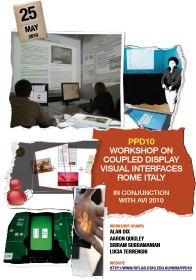 The PPD10 workshop on Coupled Display Visual Interfaces1 followed on from a previous event, PPD08 at AVI 2008 and also a workshop on “Designing And Evaluating Mobile Phone-Based Interaction With Public Displays” at CHI2008. The linking of public and private displays is something I’ve been interested in for some years and it was exciting to see some of the kinds of scenarios discussed at Lancaster as potential futures some years ago now being implemented over a range of technologies. Many of the key issues and problems proposed then are still to be resolved and new ones arising, but certainly it seems the technology is ‘coming of age’. As well as much work filling in the space of interactions, there were also papers that pushed some of the existing dimensions/classifications, in particular, Rasmus Gude’s paper on “Digital Hospitality” stretched the public/private dimension by considering the appropriation of technology in the home by house guests. The full proceedings are available at the PPD10 website.
The PPD10 workshop on Coupled Display Visual Interfaces1 followed on from a previous event, PPD08 at AVI 2008 and also a workshop on “Designing And Evaluating Mobile Phone-Based Interaction With Public Displays” at CHI2008. The linking of public and private displays is something I’ve been interested in for some years and it was exciting to see some of the kinds of scenarios discussed at Lancaster as potential futures some years ago now being implemented over a range of technologies. Many of the key issues and problems proposed then are still to be resolved and new ones arising, but certainly it seems the technology is ‘coming of age’. As well as much work filling in the space of interactions, there were also papers that pushed some of the existing dimensions/classifications, in particular, Rasmus Gude’s paper on “Digital Hospitality” stretched the public/private dimension by considering the appropriation of technology in the home by house guests. The full proceedings are available at the PPD10 website.
AVI 2010
AVI is always a joy, and AVI 2010 no exception; a biennial, single-track conference with high-quality papers (20% accept rate this year), and always in lovely places in Italy with good food and good company! I first went to AVI in 1996 when it was in Gubbio to give a keynote “Closing the Loop: modelling action, perception and information“, and have gone every time since — I always say that Stefano Levialdi is a bit like a drug pusher, the first experience for free and ever after you are hooked! The high spot this year was undoubtedly Hitomi Tsujita‘s “Complete fashion coordinator”2, a system for using social networking to help choose clothes to wear — partly just fun with a wonderful video, but also a very thoughtful mix of physical and digital technology.


images from Complete Fashion Coordinator
The keynotes were all great, Daniel Keim gave a really lucid state of the art in Visual Analytics (more later) and Patrick Lynch a fresh view of visual understanding based on many years experience and highlighting particularly on some of the more immediate ‘gut’ reactions we have to interfaces. Daniel Wigdor gave an almost blow-by-blow account of work at Microsoft on developing interaction methods for next-generation touch-based user interfaces. His paper is a great methodological exemplar for researchers combining very practical considerations, more principled design space analysis and targeted experimentation.
Looking more at the detail of Daniel’s work at Microsoft, it is interesting that he has a harder job than Apple’s interaction developers. While Apple can design the hardware and interaction together, MS as system providers need to deal with very diverse hardware, leading to a ‘least common denominator’ approach at the level of quite basic touch interactions. For walk-up-and use systems such as Microsoft Surface in bar tables, this means that users have a consistent experience across devices. However, I did wonder whether this approach which is basically the presentation/lexical level of Seeheim was best, or whether it would be better to settle at some higher-level primitives more at the Seeheim dialog level, thinking particularly of the way the iPhone turns pull down menus form web pages into spinning selectors. For devices that people own it maybe that these more device specific variants of common logical interactions allow a richer user experience.
The complete AVI 2010 proceedings (in colour or B&W) can be found at the conference website.
The very last session of AVI was a panel I chaired on “Visual Analytics: people at the heart of data” with Daniel Keim, Margit Pohl, Bob Spence and Enrico Bertini (in the order they sat at the table!). The panel was prompted largely because the EU VisMaster Coordinated Action is producing a roadmap document looking at future challenges for visual analytics research in Europe and elsewhere. I had been worried that it could be a bit dead at 5pm on the last day of the conference, but it was a lively discussion … and Bob served well as the enthusiastic but also slightly sceptical outsider to VisMaster!
As I write this, there is still time (just, literally weeks!) for final input into the VisMaster roadmap and if you would like a draft I’ll be happy to send you a PDF and even happier if you give some feedback 🙂
Search Computing
I was invited to go to this one-day workshop and had the joy to travel up on the train from Rome with Stu Card and his daughter Gwyneth.
 The search computing workshop was organised by the SeCo project. This is a large single-site project (around 25 people for 5 years) funded as one of the EU’s ‘IDEAS Advanced Grants’ supporting ‘investigation-driven frontier research’. Really good to see the EU funding work at the bleeding edge as so many national and European projects end up being ‘safe’.
The search computing workshop was organised by the SeCo project. This is a large single-site project (around 25 people for 5 years) funded as one of the EU’s ‘IDEAS Advanced Grants’ supporting ‘investigation-driven frontier research’. Really good to see the EU funding work at the bleeding edge as so many national and European projects end up being ‘safe’.
The term search computing was entirely new to me, although instantly brought several concepts to mind. In fact the principle focus of SeCo is the bringing together of information in deep web resources including combining result rankings; in database terms a form of distributed join over heterogeneous data sources.
The work had many personal connections including work on concept classification using ODP data dating back to aQtive days as well as onCue itself and Snip!t. It also has similarities with linked data in the semantic web word, however with crucial differences. SeCo’s service approach uses meta-descriptions of the services to add semantics, whereas linked data in principle includes a degree of semantics in the RDF data. Also the ‘join’ on services is on values and so uses a degree of run-time identity matching (Stu Card’s example was how to know that LA=’Los Angeles’), whereas linked data relies on URIs so (again in principle) matching has already been done during data preparation. My feeling is that the linking of the two paradigms would be very powerful, and even for certain kinds of raw data, such as tables, external semantics seems sensible.
One of the real opportunities for both is to harness user interaction with data as an extra source of semantics. For example, for the identity matching issue, if a user is linking two data sources and notices that ‘LA’ and ‘Los Angeles’ are not identified, this can be added as part of the interaction to serve the user’s own purposes at that time, but by so doing adding a special case that can be used for the benefit of future users.
While SeCo is predominantly focused on the search federation, the broader issue of using search as part of algorithmics is also fascinating. Traditional algorithmics assumes that knowledge is basically in code or rules and is applied to data. In contrast we are seeing the rise of web algorithmics where knowledge is garnered from vast volumes of data. For example, Gianluca Demartini at the workshop mentioned that his group had used the Google suggest API to extend keywords and I’ve seen the same trick used previously3. To some extent this is like classic techniques of information retrieval, but whereas IR is principally focused on a closed document set, here the document set is being used to establish knowledge that can be used elsewhere. In work I’ve been involved with, both the concept classification and folksonomy mining with Alessio apply this same broad principle.
The slides from the workshop are appearing (but not all there yet!) at the workshop web page on the SeCo site.
- yes I know this doesn’t give ‘PPD’ this stands for “public and private displays”[back]
- Hitomi Tsujita, Koji Tsukada, Keisuke Kambara, Itiro Siio, Complete Fashion Coordinator: A support system for capturing and selecting daily clothes with social network, Proceedings of the Working Conference on Advanced Visual Interfaces (AVI2010), pp.127–132.[back]
- The Yahoo! Related Suggestions API offers a similar service.[back]
morning newspaper: MPs and Elgin Marbles
I usually only read the newspaper when travelling and either do the ‘free mineral water with newspaper’ deal (usually the Telegraph, maybe the only way they can sell newspapers), or whatever they have in the hotel or plane.
The front-page news today is the Israeli attack on the Gaza aid convoy, which needs no further comment.
of MPs
However, I also got yesterday’s Independent when I arrived at the Holiday Inn near midnight. One of the main stories then was still the ‘outing’ and resignation of David Laws. The key issue here (at least in principle) was not that nature of his personal relationships, but that he had not disclosed that the flat on which he was claiming rent belonged to his partner.
I was glad to see Mark Pack’s commentary in today’s Independent take a robust view of this, noting that while Laws may have broken rules (still to be determined), there had been no financial gain involved, and indeed the arrangement had saved the taxpayer money. Pack’s contempt of the Telegraph was perhaps not unexpected in a column in a rival newspaper, but echoed my own feelings.
I was happily abroad during the height of the MPs expense ‘scandal’ last year, but was appalled at the coverage, not least because my travels take me to countries in Europe which would give anything to have the high standards of public office we take for granted in the UK. In the end a handful of MPs may (still sub judice) have abused the system, but the vast majority were simply trying to do their job.
A short while ago I happened on the web on a page detailing the expenses of a Cardiff (now ex) MP Julie Morgan, when MPs expenses came under the spotlight, she rechecked her previous claims and indeed, with more careful checking, it turned out that the claims she had made on her mortgage did not match the actual expenditure. Over the five years of the last parliament she had accidentally over-claimed in two years to the total of £800 … but in the other three years had under-claimed to the tune of £1900. The rules meant she could not retrospectively be paid for the under-claimed years, but did pay back the £800 for the over-claims. Despite being £1100 out of pocket, one of the lowest claiming MPs and indeed paying significant amount of her own salary to help maintain her constituency office, on the books she will part of the statistics of the large number of MPs who repaid expenses and so appear to have been doing wrong. Crazy!
and of Marbles
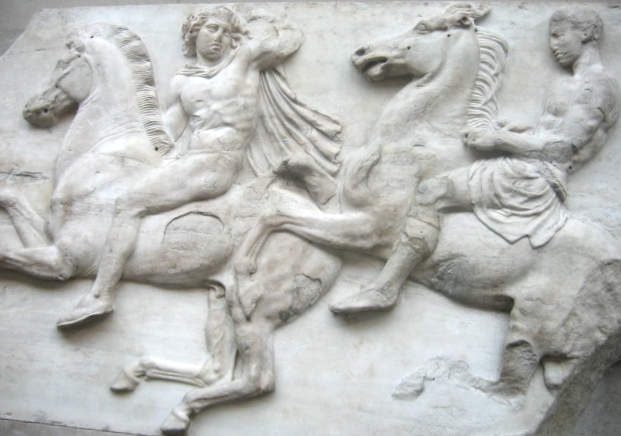 Back to today’s newspaper and deeper into the Independent a very old story that is entering a new phase: the fight for the return of treasures from around the world displayed in British Museums. The most well know is of course the Elgin Marbles (maybe Germany may claim them as security for Greece’s Euro-bailout), but others include African treasures taken during punitive raids by British soldiers in the 19th Century.
Back to today’s newspaper and deeper into the Independent a very old story that is entering a new phase: the fight for the return of treasures from around the world displayed in British Museums. The most well know is of course the Elgin Marbles (maybe Germany may claim them as security for Greece’s Euro-bailout), but others include African treasures taken during punitive raids by British soldiers in the 19th Century.
The issues seem clear-cut for a Liberal-minded Independent reader, but maybe things are more complicated; certainly some of the items, including the bronze ‘Birmingham Buddha’ would not have survived to the present day if they had not been removed – if only the Victorian adventurers had also removed some of the giant Buddha statues destroyed by the Taliban in the 1990s.
I wonder how far repatriation should go, what is the statute of limitations for national treasure? Maybe as the Birmingham Buddha travels back to India, several hundred shiploads of railtrack and steam trains will be repatriated to the UK, offloaded at Felixstowe docks and moved overland to form a mountainous sculpture of piled steel in the centre of Birmingham.
 Having just been in Italy, I am sure there are many Italian artefacts in British museums, but then in Rome there are a number of Egyptian obelisk’s removed by the Romans 2000 years ago. However, I would be surprised if, in turn, the Egyptians had not taken artefacts from other parts of the ancient world. For that matter, what about the work done by the Israelites in Egypt before the Exodus? If not for the fear it might be taken seriously I might suggest Israel could claim this.
Having just been in Italy, I am sure there are many Italian artefacts in British museums, but then in Rome there are a number of Egyptian obelisk’s removed by the Romans 2000 years ago. However, I would be surprised if, in turn, the Egyptians had not taken artefacts from other parts of the ancient world. For that matter, what about the work done by the Israelites in Egypt before the Exodus? If not for the fear it might be taken seriously I might suggest Israel could claim this.
In fact, these treasures are often more symbolic of the greater rape of natural resources and human labour that still continues today in many parts of the world today. Indeed being brought up in the shadow of the South Wales coal valleys, I am well aware that the benefits of natural resources rarely go to the countries where they are found nor the labourers who mine them.
One of the key arguments against repatriation of ancient artefacts is that the curatorial standards are higher where they are presently. Indeed the pillage of Iraqi sites after the fall of Saddam could be seen as overwhelming evidence that institutions such as the British Museum do the whole world a service. Repatriation of artefacts to less secure countries would put at risk our shared global heritage; after all who knows what civilisation the UK and US will decide to decimate next.

